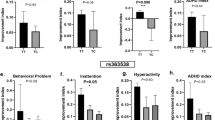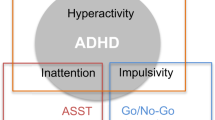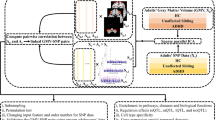Abstract
The glutamate system may be involved in the development of attention-deficit/hyperactivity disorder (ADHD) based on animal models and the role of N-methyl-D-aspartate receptors (NMDAR) in cognition and motor processes. A follow-up study of the first genome scan for ADHD identified significant evidence for linkage to the 16p13 region.1 The glutamate receptor, ionotropic, N-methyl D-aspartate 2A (GRIN2A) gene that encodes the 2A subunit of the NMDA receptor, resides in this region and a recent study has reported an association between this gene and ADHD.2 We tested for linkage between the alleles and haplotypes of four polymorphisms at the GRIN2A locus and ADHD in our sample of 183 nuclear families with 229 affected children. In contrast to previous findings, we did not identify any evidence for a relationship of these markers and ADHD. Owing to the role of GRIN2A in aspects of cognition, we investigated the relationship of this gene to the cognitive phenotypes of inhibitory control, verbal short-term memory and verbal working memory. There was no significant evidence of linkage between GRIN2A and these phenotypes. While the results were not significant in our sample, the previous association finding suggests that further study of this gene is warranted.
This is a preview of subscription content, access via your institution
Access options
Subscribe to this journal
Receive 12 print issues and online access
$259.00 per year
only $21.58 per issue
Buy this article
- Purchase on Springer Link
- Instant access to full article PDF
Prices may be subject to local taxes which are calculated during checkout
Similar content being viewed by others
References
Smalley SL, Kustanovich V, Minassian SL, Stone JL, Ogdie MN, McGough JJ et al. Genetic linkage of attention-deficit/hyperactivity disorder on chromosome 16p13, in a region implicated in autism. Am J Hum Genet 2002; 71: 959–963.
Turic D, Langley K, Mills S, Stephens M, Lawson D, Govan C et al. Follow-up of genetic linkage findings on chromosome 16p13: evidence of association of N-methyl-Daspartate glutamate receptor 2A gene polymorphism with ADHD. Mol Psychiatry, (in press).
Pennington BF, Ozonoff S . Executive functions and developmental psychopathology. J Child Psychol Psychiatry 1996; 37: 51–87.
Quay HC . Inhibition and attention deficit hyperactivity disorder. J Abnorm Child Psychol 1997; 25: 7–13.
Schachar R, Logan GD . Impulsivity and inhibitory control in normal development and childhood psychopathology. Dev Psychol 1990; 26: 710–720.
Schachar R, Mota VL, Logan GD, Tannock R, Klim P . Confirmation of an inhibitory control deficit in attention-deficit/hyperactivity disorder. J Abnorm Child Psychol 2000; 28: 227–235.
Logan GD . On the ability to inhibit thought and action: a users' guide to the stop signal paradigm. In: Carr DD, Carr TH (eds) Inhibitory Processes in Attention, Memory, and Language. Academic Press: San Diego, CA, 1994 pp 189–239.
Barnett R, Maruff P, Vance A, Luk ES, Costin J, Wood C et al. Abnormal executive function in attention deficit hyperactivity disorder: the effect of stimulant medication and age on spatial working memory. Psychol Med 2001; 31: 1107–1115.
Miyamoto Y, Yamada K, Noda Y, Mori H, Mishina M, Nabeshima T . Hyperfunction of dopaminergic and serotonergic neuronal systems in mice lacking the NMDA receptor epsilon1 subunit. J Neurosci 2001; 21: 750–757.
Lee I, Kesner RP . Differential contribution of NMDA receptors in hippocampal subregions to spatial working memory. Nat Neurosci 2002; 5: 162–168.
Taffe MA, Davis SA, Gutierrez T, Gold LH . Ketamine impairs multiple cognitive domains in rhesus monkeys. Drug Alcohol Depend 2002; 68: 175–187.
Newcomer JW, Farber NB, Jevtovic-Todorovic V, Selke G, Melson AK, Hershey T et al. Ketamine-induced NMDA receptor hypofunction as a model of memory impairment and psychosis. Neuropsychopharmacology 1999; 20: 106–118.
Grunwald T, Beck H, Lehnertz K, Blumcke I, Pezer N, Kurthen M et al. Evidence relating human verbal memory to hippocampal N-methyl-D-aspartate receptors. Proc Natl Acad Sci USA 1999; 96: 12085–12089.
Adler CM, Goldberg TE, Malhotra AK, Pickar D, Breier A . Effects of ketamine on thought disorder, working memory, and semantic memory in healthy volunteers. Biol Psychiatry 1998; 43: 811–816.
Carlsson M, Carlsson A . The NMDA antagonist MK-801 causes marked locomotor stimulation in monoamine-depleted mice. J Neural Transm 1989; 75: 221–226.
Corbett R, Camacho F, Woods AT, Kerman LL, Fishkin RJ, Brooks K et al. Antipsychotic agents antagonize non-competitive N-methyl-D-aspartate antagonist-induced behaviors. Psychopharmacology (Berl) 1995; 120: 67–74.
Zhang WN, Bast T, Feldon J . Effects of hippocampal N-methyl-D-aspartate infusion on locomotor activity and prepulse inhibition: differences between the dorsal and ventral hippocampus. Behav Neurosci 2002; 116: 72–84.
Sakimura K, Kutsuwada T, Ito I, Manabe T, Takayama C, Kushiya E et al. Reduced hippocampal LTP and spatial learning in mice lacking NMDA receptor epsilon 1 subunit. Nature 1995; 373: 151–155.
Fisher SE, Francks C, McCracken JT, McGough JJ, Marlow AJ, MacPhie IL et al. A genomewide scan for loci involved in attention-deficit/hyperactivity disorder. Am J Hum Genet 2002; 70: 1183–1196.
Ioannidis JP, Ntzani EE, Trikalinos TA, Contopoulos-Ioannidis DG . Replication validity of genetic association studies. Nat Genet 2001; 29: 306–309.
Holmes J, Payton A, Barrett JH, Hever T, Fitzpatrick H, Trumper AL et al. A family-based and case–control association study of the dopamine D4 receptor gene and dopamine transporter gene in attention deficit hyperactivity disorder. Mol Psychiatry 2000; 5: 523–530.
Barr CL, Wigg K, Malone M, Schachar R, Tannock R, Roberts W et al. Linkage study of catechol-O-methyltransferase and attention-deficit hyperactivity disorder. Am J Med Genet 1999; 88: 710–713.
Logan GD, Cowan WB . On the ability to inhibit thought and action: a theory of an act of control. Psychol Rev 1984; 91: 295–327.
Williams BR, Ponesse JS, Schachar RJ, Logan GD, Tannock R . Development of inhibitory control across the life span. Dev Psychol 1999; 35: 205–213.
Kaplan E, Fein D, Kramer J, Delis D, Morris R . WISC-III PI Manual The Psychological Corporation: San Antonio, TX, 1999.
Williams NM, Bowen T, Spurlock G, Norton N, Williams HJ, Hoogendoorn B et al. Determination of the genomic structure and mutation screening in schizophrenic individuals for five subunits of the N-methyl-D-aspartate glutamate receptor. Mol Psychiatry 2002; 7: 508–514.
Itokawa M, Yamada K, Yoshitsugu K, Toyota T, Suga T, Ohba H et al. A microsatellite repeat in the promoter of the N-methyl-D-aspartate receptor 2A subunit (GRIN2A) gene suppresses transcriptional activity and correlates with chronic outcome in schizophrenia. Pharmacogenetics 2003; 13: 271–278.
Sham PC, Curtis D . An extended transmission/disequilibrium test (TDT) for multi-allele marker loci. Ann Hum Genet 1995; 59(Part 3): 323–336.
Clayton D . A generalization of the transmission/disequilibrium test for uncertain-haplotype transmission. Am J Hum Genet 1999; 65: 1170–1177.
Horvath S, Xu X, Laird NM . The family based association test method: strategies for studying general genotype–phenotype associations. Eur J Hum Genet 2001; 9: 301–306.
Acknowledgements
This work was supported by grants from the Natural Sciences and Engineering Research Council (JHA), The Hospital for Sick Children Psychiatric Endowment Fund (CLB), the Canadian Institutes of Health Research MT14336 (CLB) and MOP-14336 (CLB). Also, we thank Drs Anita Thapar and Michael O'Donovan for providing information on the Grin2a-5 polymorphism prior to publication.
Author information
Authors and Affiliations
Corresponding author
Rights and permissions
About this article
Cite this article
Adams, J., Crosbie, J., Wigg, K. et al. Glutamate receptor, ionotropic, N-methyl D-aspartate 2A (GRIN2A) gene as a positional candidate for attention-deficit/hyperactivity disorder in the 16p13 region. Mol Psychiatry 9, 494–499 (2004). https://doi.org/10.1038/sj.mp.4001455
Received:
Revised:
Accepted:
Published:
Issue Date:
DOI: https://doi.org/10.1038/sj.mp.4001455
Keywords
This article is cited by
-
Gene Interaction of Dopaminergic Synaptic Pathway Genes in Attention-Deficit Hyperactivity Disorder: a Case-Control Study in Chinese Children
Molecular Neurobiology (2024)
-
A next generation sequencing gene panel for use in the diagnosis of anorexia nervosa
Eating and Weight Disorders - Studies on Anorexia, Bulimia and Obesity (2022)
-
The effects of GRIN2B and DRD4 gene variants on local functional connectivity in attention-deficit/hyperactivity disorder
Brain Imaging and Behavior (2018)
-
Association between the GRM7 rs3792452 polymorphism and attention deficit hyperacitiveity disorder in a Korean sample
Behavioral and Brain Functions (2013)
-
The uncompetitive NMDA receptor antagonists ketamine and memantine preferentially increase the choice for a small, immediate reward in low-impulsive rats
Psychopharmacology (2013)



